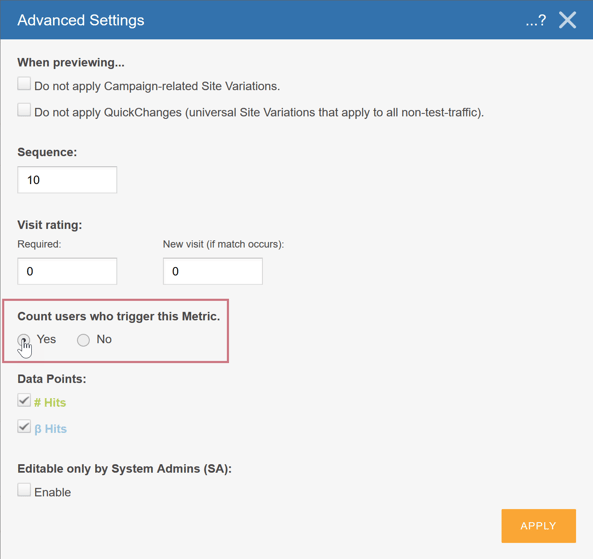The main point of running a Campaign is to see if the Variations you design actually affect the actions of visitors to your website. You can track the number of visitors who were exposed to a Variation easily by selecting Count User When Triggered (set to Yes by default) in the Advanced Settings area of the Factor page for that Variation. Generally, this is a good way to count visits, but it tells you only how many visitors saw the Variation. It does not tell you if seeing the Variation caused visitors to react to it and more importantly, to complete a transaction, or some other action you're driving them toward. You'll need to use a Metric for that.
For example, let’s say that you’ve designed a Factor for a page on your website that lists a number of types of winter boots. You’ve also created a Variation of that page that contains a box with a message that offers visitors a 20% discount. You want to know if that Variation with the discount causes visitors to actually make a purchase. You can measure that using a counting Metric to see how many visitors who were exposed to the Variation landed on the Checkout Complete page.
Creating a Counting Metric
You create a counting Metric the same way you create any other Metric. The difference is that on the Advanced Settings pane, select Yes in the Count users who trigger this Metric field. When you add this Metric to a Campaign, visitors are counted only if they trigger this Metric.
To set this up:
- Select New, Metric.
- Name the Metric and click Save.
- On the right side of the page, click Show Advanced Settings. The Advanced Settings dialog opens.

- In the Advanced Settings Dialog, select Count users who trigger this Metric.
- Click Apply on the Advanced Settings dialog and then click Save for the Metric.
Using EventTrack for Counting Metrics
SiteSpect's EventTrack library allows you to use JavaScript to track visitor actions such as clicks, page transitions, and more. For each action you want to track, you must create a Metric. In addition, since you want the code to work for all Variation Groups in a Campaign, use a Campaign Variation to implement the script for your Campaign. You'll need to complete the following steps:
- Write the EventTrack script.
- Create a Campaign Variation that includes the script.
- Associate the Campaign Variation with a Campaign.
Where Can I Use Counting Metrics?
Origin Experiments
When you run an Origin Experiment, the Variations are reflected on the origin, which means that SiteSpect does not know where these changes have been implemented on the website. As a result, SiteSpect does not know when visitors see Variations that are part of the Campaign. You can manually manage counting visitors by creating a counting Metric for that Campaign. When a visitor is exposed to the change the Metric is triggered and serves as your counting criteria in SiteSpect.
Client-Side Factors
Client-Side Factors work by injecting JavaScript on an HTML page. Changes are then applied as the visitor interacts with the page and the DOM mutates. Client-Side Factors do not count visitors when the JavaScript is injected. Because all the Variations are made on the client side, SiteSpect does not know if the visitor sees them. You can get around this by creating a counting Metric that is triggered when the visitor sees a Variation. In this scenario, you can make an EventTrack request when your JavaScript Variation code makes a change and then use this Metric as a counter for that test.
Additional Use Cases
There many other use cases in which counting Metrics work better than the standard counting settings for Factors. For example, if you are editing content in the footer of a page or in an area that a visitor must scroll to, you'd probably want to use a counting Metric. If you are making changes to a pop-up or flyover, which is not displayed on the page by default, you may want to use a counting Metric. These are all examples of when you want to change the HTML of a page but don’t necessarily want to count visitors until they are exposed to the change.
Additional pages to support this topic can be found below: